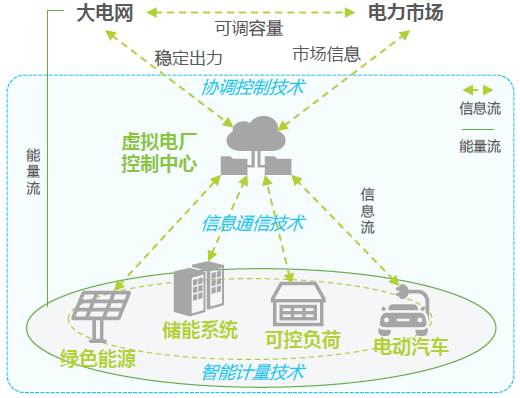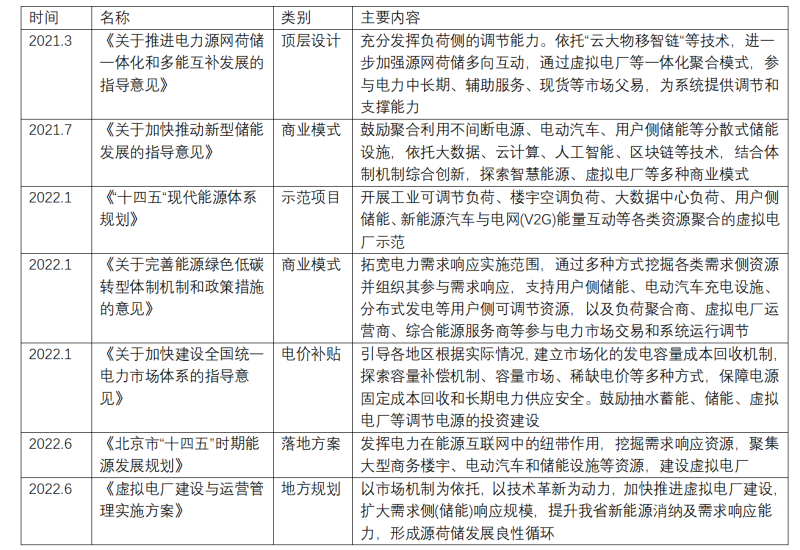| Virtual Power Plant: "Switch" to Improve the Flexibility of Power Syst |
| Release time:2023-01-05 14:01:34| Viewed: |
Virtual Power Plant: "Switch" to Improve the Flexibility of Power System
In order to achieve the goal of "double carbon", China is accelerating the adjustment of energy structure and increasing the proportion of renewable energy. The total installed capacity of wind and solar power generation in China is planned to reach more than 1.2 billion kilowatts by 2030, forming an energy system dominated by renewable energy. A high proportion of renewable energy will be connected to the grid, the level of electrification of energy consumption terminals will be improved, and power electronics and large-scale distributed new energy will be connected to the grid, which will make the power system balance, regulation and support capacity face great challenges. Improving the flexibility of the power system is an important means to achieve clean and low-carbon development of energy and electricity.
During the "13th Five Year Plan" period, the reality that China's power system lacks flexibility and regulation capability has made it difficult for the power system to fully adapt to the explosive growth of new energy. The power system is faced with many problems, such as insufficient new energy consumption capacity, reduced system reliability, increased energy consumption risk of users, and rising system cost due to limited flexibility resources.
To access a high proportion of renewable energy and improve the power system regulation capacity, more flexible resources need to be introduced, such as accelerating the construction of virtual power plants.
Virtual Power Plants (VPPs) aggregate one or more resources from different spaces, such as adjustable (interruptible) loads, energy storage, microgrids, electric vehicles, distributed power generation, etc., to achieve autonomous coordination and optimal control, and participate in power system operation and power market transactions. The new business form of virtual power plant can not only be used as a "positive power plant" to supply power to the system for peak load regulation, but also as a "negative power plant" to increase load consumption and cooperate with the system to fill the valley.
Figure Schematic Diagram of Virtual Power Plant Operation
Compared with the traditional electric power energy ecosystem, the biggest change of the ecosystem under the virtual power plant is that the traditional electric power energy ecosystem has a clear boundary of power generation, transmission, distribution and use, and the operation mode of "source follows load" has been transformed into a cross boundary of power generation, transmission, distribution and use. At the same time, it has the role of both producers and consumers. The operation mode is shown as "source load interaction". Every part of the interior is a small energy system, It belongs to the expansion of smart grid.
Virtual power plants can be divided into three categories: (1) load virtual power plants: virtual power plant operators aggregate their bound market-oriented power users with load regulation capability (including electric vehicles, adjustable loads, interruptible loads, etc.), and form virtual power plants as a whole (in a load state) to provide flexible response regulation services on the load side. (2) Virtual power plant on the power side: build a virtual power plant on the distributed power generation side. (3) Virtual power plant integrating source, grid, load and storage: it gathers power generation sources and load users, participates in the power market as a centralized power plant and an independent market entity, and does not occupy the peak shaving capacity of the system in principle.
Since 2021, the state and local governments have successively introduced policies related to virtual power plants, and some provinces and cities have also introduced clear implementation plans or subsidy standards.
Table 1 Main Policies of Virtual Power Plants from 2021 to 2022
From the perspective of policy environment, the virtual power plant demonstration project launched by two major power grid companies mainly takes demand side response as the profit model. The local government has successively introduced the auxiliary service market policy to guide the virtual power plant to participate in the peak shaving and frequency modulation of the power system. With the continuous promotion of the spot power market, more demonstration projects may innovate feasible business models.
From the perspective of the current development of the virtual power plant industry, the European and American power markets are relatively mature, and the virtual power plants have been commercialized. However, China is still in the early pilot stage of virtual power plants, and the business model is not clear enough. Virtual power plant pilot sites have appeared in Jiangsu, Zhejiang, Shenzhen, Shanghai and other places.
Table 2 Summary of typical cases of domestic virtual power plants
Most domestic virtual power plants are in the pilot demonstration stage, with unclear business models and few actual profitable projects. Why is the development of overseas virtual power plants mature, while China is still in the pilot stage?
Let's refer to the successful experience of Next Kraftwerke, the largest virtual power plant in Europe.
Next Kraftwerke is an energy dealer certified by the European Power Exchange Market (EPEX) and participates in the spot market transaction of energy.
Next Kraftwerke has created amazing development speed and excellent business performance through its superb resource aggregation ability and innovative business model. Its main profit models include: (1) participating in electricity market transactions. (2) Demand response, peak shaving and valley filling. (3) Participate in grid ancillary services.
The successful experience of European virtual power plants tells us that a mature spot power market is a sufficient condition for virtual power plants to obtain economy, and the development of distributed generation+distribution network is a necessary condition for the development of virtual power plants.
If European virtual power plants focus more on the generation side, take the integration of distributed power generation and energy storage resources as the direction, and take the consumption of new energy as the main goal, American virtual power plants focus on the user side resources, and take the acquisition of auxiliary service compensation as the profit model.
The United States is rich in solar energy resources. Driven by a large number of government subsidies and incentives, household photovoltaic energy storage systems have gradually become an alternative for residents to reduce the cost of electricity prices, so as to achieve spontaneous self use of electricity. Tesla lays out a household energy storage Powerwall and cooperates with public utility companies to carry out a virtual power plant program. Tesla has successively carried out virtual power plant projects with such public utilities as EnergyLocals, Green Mountain Power, PG&E and power retailers. These projects have helped Tesla rapidly expand the installation of energy storage systems. At the same time, power retailers can obtain part of the use rights of these distributed battery power by signing agreements with Powerwall users, so as to aggregate demand side resources and realize the commercial expansion of virtual power plants.
The successful experience of virtual power plants in the United States tells us that by giving full play to the regulating role of energy storage in distributed energy, the terminal energy consumption can be transformed from the original "rigid load" of the grid to "flexible load", and contribute to the realization of "carbon neutrality" with zero emissions of comprehensive electrification.
Compared with European and American countries, China's virtual power plants started late, the spot market of electricity was not mature, and multiple resources such as power generation side, energy storage side and user side were taken into account, with a complex structure. As the transformation of energy structure driven by "dual carbon" brings great challenges to the flexibility regulation of power system, virtual power plant can become a "switch" to improve the flexibility of power system.
Looking forward to the future, the virtual power plant can achieve rapid development with external policies superimposed on the internal demand of the power grid.
First, the development of distributed energy has become an opportunity for the development of virtual power plants. China's scenery bases are concentrated in the west and north, while the power load is concentrated in the middle and east. The national energy structure promotes the development of distributed energy. Under this background, virtual power plant, intelligent microgrid and other models emerge as the times require. The virtual power plant can act as the intermediary between distributed resources, power grid operators and power trading market. With the maturity of the spot power market, energy trading can be realized.
Second, digital means drive the construction of virtual power plants. By using digital technology, virtual power plant and energy storage can become the key components of building a new power system, and an important way to improve the intelligent coordination and efficiency of the power system. For example, through the cloud platform of virtual power plants, the aggregation function of virtual power plants can be used to form a large-scale "peak cutting and valley filling" response to maximize the use of resources.
Third, the competition in the virtual power plant market will become increasingly fierce. Virtual power plant is a highly capital, resource and technology intensive industry with great development potential and certain industry entry barriers. Most of the entrants are leading enterprises with strong resource integration capabilities or resource endowment advantages. Although the current market concentration is not high, it is estimated that the industry competition will intensify in the future, especially in the midstream resource aggregators. |






